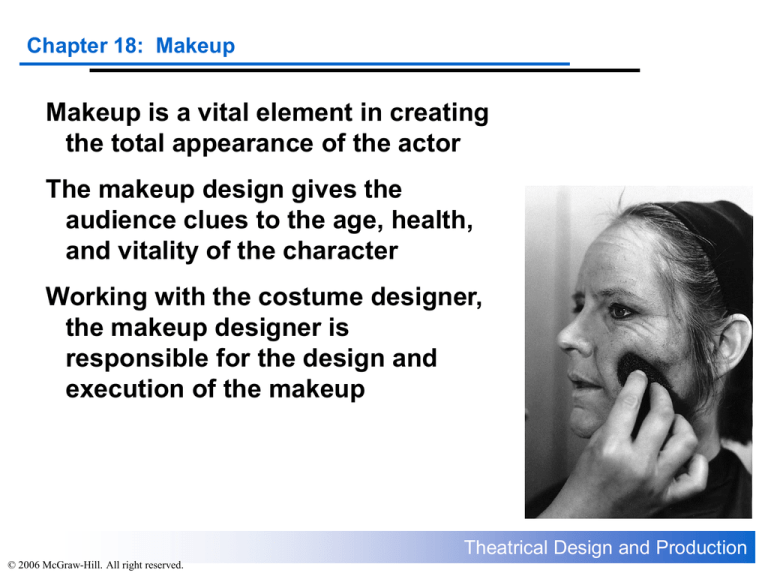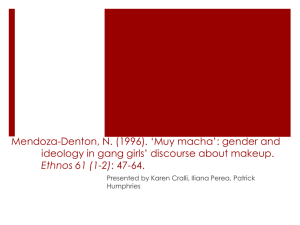
Chapter 18: Makeup
Makeup is a vital element in creating
the total appearance of the actor
The makeup design gives the
audience clues to the age, health,
and vitality of the character
Working with the costume designer,
the makeup designer is
responsible for the design and
execution of the makeup
Theatrical Design and Production
© 2006 McGraw-Hill. All right reserved.
Chapter 18: Makeup
Designing the Makeup
The makeup designer must design the makeup to
transform the actor into the character
The designer should be aware if genetics, exposure to
the elements, skin deformities, and historical period
Theatrical Design and Production
© 2006 McGraw-Hill. All right reserved.
Chapter 18: Makeup
Designing the Makeup
The makeup designer’s process is similar
to that of other designers
Read the script
Attend production meetings
Hold individual conferences with the director,
costume designer, and actors
Do research
Provide sketches
Apply makeup for production
Theatrical Design and Production
© 2006 McGraw-Hill. All right reserved.
Chapter 18: Makeup
Designing the Makeup
Makeup Drawings
Preliminary sketches
Quick sketches drawn in any
medium that show what the
makeup should look like
Theatrical Design and Production
© 2006 McGraw-Hill. All right reserved.
Chapter 18: Makeup
Designing the Makeup
Makeup Drawings
Predrawn makeup worksheets
If the designer is inexperienced with
sketching, these worksheets of frontal
and profile views can be helpful
Theatrical Design and Production
© 2006 McGraw-Hill. All right reserved.
Chapter 18: Makeup
Designing the Makeup
Makeup Drawings
Makeup design adapted to the actor
Once the design is finalized, it
should be adapted to the actor
This can be done by placing
tracing paper over a photo of
the actor
This same process can also be
done on the computer, using
software programs such as
PhotoShop
Theatrical Design and Production
© 2006 McGraw-Hill. All right reserved.
Chapter 18: Makeup
Designing the Makeup
Makeup Drawings
Working drawings
These drawing provide detailed
information that shows the actor
or makeup artist how to apply the
makeup
These drawing usually show frontal
and profile views, as well as
detailed notes
Theatrical Design and Production
© 2006 McGraw-Hill. All right reserved.
Chapter 18: Makeup
Types of Makeup
Various materials are used for makeup base, liners,
beards, mustaches, and prosthetic devices
Cake makeup
Creme makeup
Liquid makeup
Dry makeup
Greasepaint
Rubber-Mask Greasepaint
Makeup Removers
Theatrical Design and Production
© 2006 McGraw-Hill. All right reserved.
Chapter 18: Makeup
Types of Makeup
Cake Makeup
The most common type of theatrical makeup
Dry or moist, cake makeup is pigmented material
compressed into cake form
A variety of bases as well as highlight and
shadow colors are available
Can be applied with natural silk sponges, and
brushes are used for detailed work
Cake makeup does not require powdering
Theatrical Design and Production
© 2006 McGraw-Hill. All right reserved.
Chapter 18: Makeup
Types of Makeup
Creme Makeup
A moist, nongreasy foundation
Creme makeup can be applied with a
sponge, brush, or the fingers
It is compatible with cake makeup but
requires powder to be set
Creme makeup is also
available in stick
form—called crayons
Theatrical Design and Production
© 2006 McGraw-Hill. All right reserved.
Chapter 18: Makeup
Types of Makeup
Liquid Makeup
Liquid makeup manufactured for theatrical
purposes is mainly limited to body makeup
A variety of liquid bases formulated for street
wear work perfectly well for the stage
Liquid bases dry
quickly and are hard
to blend if more than
one shade of
base is being
applied!
Theatrical Design and Production
© 2006 McGraw-Hill. All right reserved.
Chapter 18: Makeup
Types of Makeup
Dry Makeup
Dry makeup includes all makeup that is dry when applied to
the skin
Face powders and pressed powder rouge are used as
supplements to other types of makeup
Theatrical Design and Production
© 2006 McGraw-Hill. All right reserved.
Chapter 18: Makeup
Types of Makeup
Greasepaint
Until the development of quality cake
and creme makeups, greasepaint was
the most commonly used theatrical
makeup
Opaque and cream-based, it is
available in jars, tubes, and tins in a
variety of colors
Greasepaint creates a reasy, shiny base
that does not take highlights and
shadows well
It also requires a coating of powder
Greasepaint can
also clog pores
and promotes
facial
perspiration
Theatrical Design and Production
© 2006 McGraw-Hill. All right reserved.
Chapter 18: Makeup
Types of Makeup
Rubber-Mask Greasepaint
This specialty greasepaint, made with a castor-oil base, is
primarily used to cover latex
It must be thoroughly powdered before any additional makeup
can be applied
Theatrical Design and Production
© 2006 McGraw-Hill. All right reserved.
Chapter 18: Makeup
Types of Makeup
Makeup Removers
There are many brands and types of makeup
removers; here are a few
Kryolan’s Makeup Remover
Mehron’s Liquefying Cream
Ben Nye’s Quick ‘n Clean Makeup Remover
Cleansing creams, cold cream,
and baby oils sold in the
drugstore remove most types
of theatrical makeup—although
they can be slightly harsher on
the skin!
Theatrical Design and Production
© 2006 McGraw-Hill. All right reserved.
Chapter 18: Makeup
Application Techniques
Several application techniques can be used with all types
of makeup
Highlights and Shadows
Stippling
Corrective Makeup
Theatrical Design and Production
© 2006 McGraw-Hill. All right reserved.
Chapter 18: Makeup
Application Techniques
Highlights and Shadows
By painting artificial, two-dimensional
highlights and shadows on an
actor’s face, the makeup artist
manipulates the audience’s
perception of that face
Theatrical Design and Production
© 2006 McGraw-Hill. All right reserved.
Chapter 18: Makeup
Application Techniques
Highlights and Shadows
Facial highlights are simply those areas that reflect
more light that the surrounding skin reflects
Shadows are those areas that reflect less
The highlight color is a lighter version of the
foundation, while the shadow color is darker than
the foundation
Theatrical Design and Production
© 2006 McGraw-Hill. All right reserved.
Chapter 18: Makeup
Application Techniques
Stippling
Stippling is a method of applying makeup by
daubing or patting rather than stroking
Stippling with a brush or sponge roughens
the skin texture
The use of two or more stipple colors will
create a more natural look
Theatrical Design and Production
© 2006 McGraw-Hill. All right reserved.
Chapter 18: Makeup
Application Techniques
Corrective Makeup
The purpose of corrective makeup is to enhance the
natural appearance of the actor
After applying foundation or one or more colors, the
actor’s natural facial structure is either emphasized
or de-emphasized with highlights and shadows
Theatrical Design and Production
© 2006 McGraw-Hill. All right reserved.
Chapter 18: Makeup
Three-Dimensional Makeup
Three-Dimensional Makeup involves the
use of various materials to alter the
shape the actor’s face, neck, or hands
Nose Putty
Derma Wax
Gelatin
Latex
Prosthetics
Beards and Mustaches
Theatrical Design and Production
© 2006 McGraw-Hill. All right reserved.
Chapter 18: Makeup
Three-Dimensional
Makeup
Nose Putty
Nose putty can be used to
alter the shape of the nose,
chin, and other nonflexible
areas of skin
Adhesion can be increased
with the use of spirit gum
Apply foundation color and
other makeup after applying
and shaping the nose putty
Theatrical Design and Production
© 2006 McGraw-Hill. All right reserved.
Chapter 18: Makeup
Three-Dimensional Makeup
Derma Wax
Derma wax is softer than, but does not adhere as well
as, nose putty
It is used for similar modifications of hard structures,
such as noses and chins
Derma wax requires a coating of spirit gum
Theatrical Design and Production
© 2006 McGraw-Hill. All right reserved.
Chapter 18: Makeup
Three-Dimensional Makeup
Gelatin
Gelatin, such as unflavored Knox gelatin,
form a thick paste that solidifies when
cooled when combined with hot water
It can be used to form three-dimensional
shapes such as warts, scars, and
moles
Gelatin adheres to thoroughly greasefree skin and is more flexible than
nose putty and derma wax
It can be used on fleshy, flexible skin—
such as cheeks
Theatrical Design and Production
© 2006 McGraw-Hill. All right reserved.
Chapter 18: Makeup
Three-Dimensional Makeup
Latex
Several types of latex systems are used
for a variety of purposes, such as
forming prosthetic pieces, creating
wrinkles, and applying crepe hair
Liquid latex is available in clear and
flesh-colored formulations
Foam latex is soft, flexible expanding
foam that is poured into mold to form
prosthetic pieces
Latex can also be used to make bald
caps and eyebrow masks
Theatrical Design and Production
© 2006 McGraw-Hill. All right reserved.
Chapter 18: Makeup
Three-Dimensional Makeup
Prosthetics
Prosthetic devices—latex noses,
chins, bald caps, eyebrow blocks,
etc.—can either be purchased or
made in the shop
Items such as noses and chins, that
must fit well on an actor’s face,
are better created on the face or
cast from a “life mask” of the actor
Latex prosthetics can be attached to
the skin using wither latex or spirit
gum
Life mask—a
plaster mask of
a person’s face,
created using
plaster of paris
Theatrical Design and Production
© 2006 McGraw-Hill. All right reserved.
Chapter 18: Makeup
Three-Dimensional Makeup
Prosthetics
Latex prosthetics can be attached to the
skin using wither latex or spirit gum
Theatrical Design and Production
© 2006 McGraw-Hill. All right reserved.
Chapter 18: Makeup
Three-Dimensional Makeup
Beards and Mustaches
False beards and mustaches are usually
made from crepe hair, animal hair, or
human hair
Crepe hair is the least expensive and
most commonly used
Crepe, animal, and human hair are all
available in a wide variety of colors
Hair should be attached using spirit gum
Theatrical Design and Production
© 2006 McGraw-Hill. All right reserved.
Chapter 18: Makeup
Three-Dimensional
Makeup
Beards and Mustaches
Ventilated beards and
mustaches take more time
to construct but look more
realistic
Generally made from
synthetic or relatively
coarse human hair, they are
constructed on lace or
gauze backing
Theatrical Design and Production
© 2006 McGraw-Hill. All right reserved.







